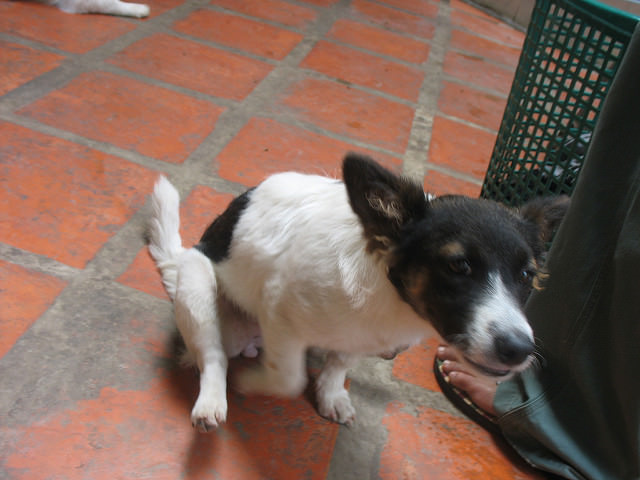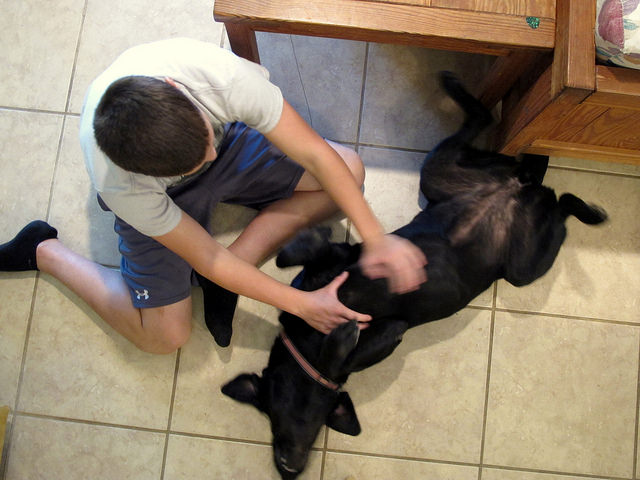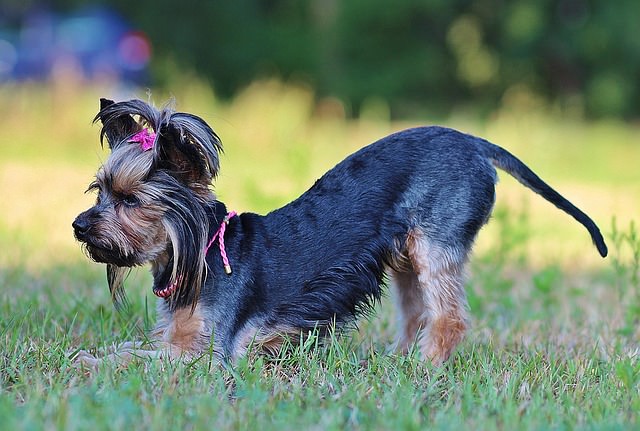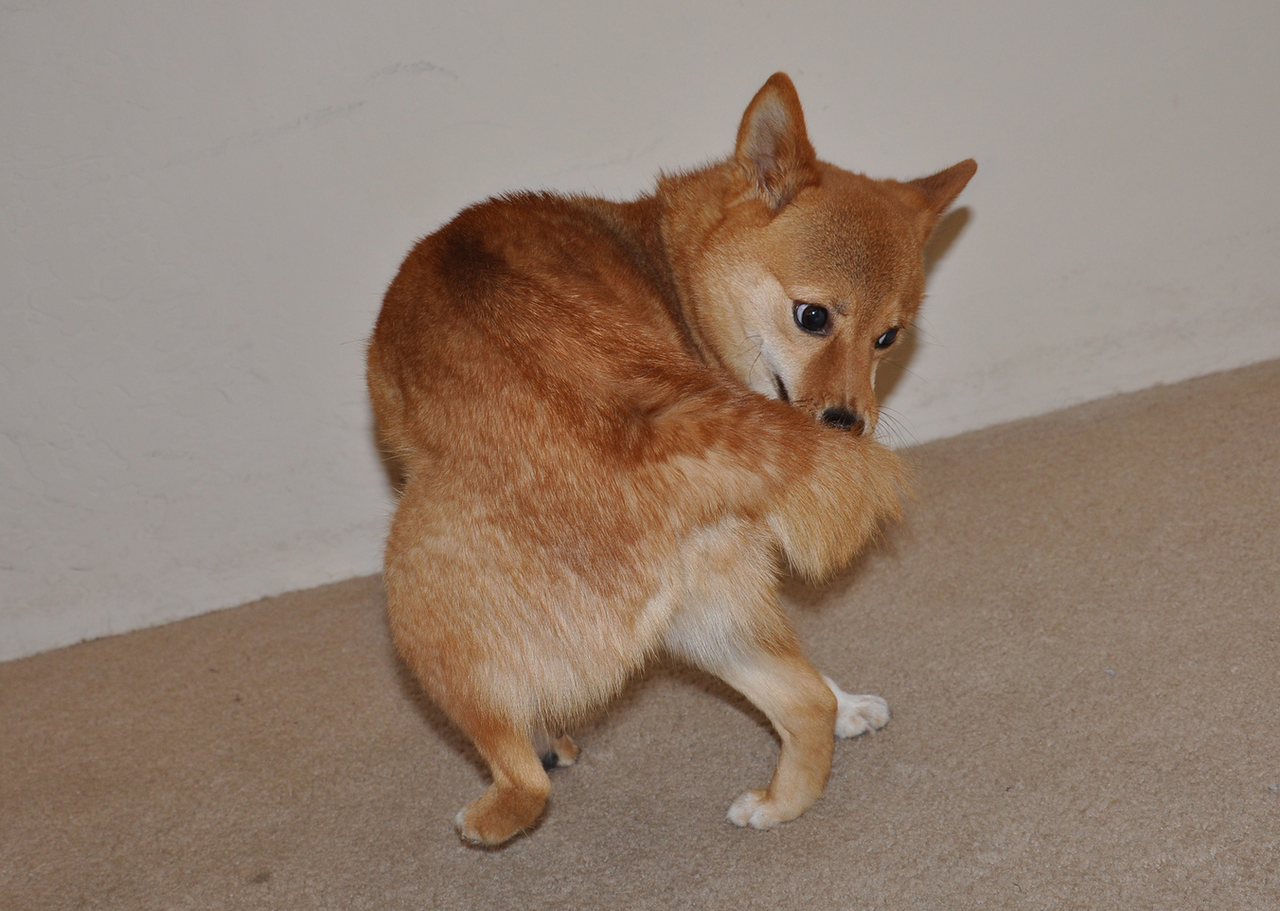Dogs do some truly amusing things. Most of their antics are harmless and fun, but there are a few that we, as humans, perceive as laughable that can actually signify a health related issue. Here are some that might raise red flags:
#1 – Scooting
People laugh at a dog dragging his rear on the floor and there is even a carpet cleaner commercial that highlights it, but actually scooting is not normal if it happens more than occasionally. If it is accompanied by licking of the perianal area, it is especially concerning because it is a sign of itching and pain.

A common cause is impaction or infection of the anal sacs. Anal sacs are small glands located on either side of the anus. Their job is to produce a secretion that to people smells extremely foul, but to dogs serves as identification, like a name tag. It is a modification of the anal sac that allows the skunk to produce his distinctive odor. Normal sacs empty their fluid when the dog defecates, but if the secretions are thickened or the emptying ducts clogged, the gland become over full and uncomfortable to the dog.
In my opinion, only a veterinarian should express the anal sacs because frequent manual emptying can create an issue where there was none before. In the past, all groomers would express the glands at the time of a bath, but it is no longer something that I recommend. If you notice your dog scooting, it is a sign that you should see your vet.
#2 – Rubbing his face
Owners think that a dog rubbing his face on them is a sign of affection like it is for a cat, but if your dog is repeatedly rubbing his face, there could be trouble. Something on his face is irritating or itching. He could be rubbing his eyes or ears. He might even have something lodged in his mouth and teeth. Especially if you notice the rubbing is extreme, you need a vet to help.

Dogs can rub their faces against items, like furniture or people or even with their own paws. Sometimes the rubbing becomes excessive enough to rub the hair away around the eyes or you might notice some other symptoms. Report everything you notice to your vet. There are things that can done to check for a corneal (eye) scratch and certainly you need to know for sure if your dog’s ears are alright and make sure there is nothing lodged in the mouth. Dogs that frantically rub their faces along the grass or constantly paw are doing so for a reason. Tell your vet.
#3 – Kicking a foot when scratched
We all laugh when dogs scratch their back foot when we find an itchy spot to pet, but sometimes it is indicative of excessive itching. Normal parasite-free dogs don’t spend a lot of time scratching, so if you notice your dog scratching frequently, there could be trouble.

Part the hair on your dog’s rump above his tail and see if you can see signs of fleas. Tiny blacks specks might appear at the base of the hair and if you see the specks and wet them with water or rubbing alcohol, they appear reddish, like the blood that the fleas ingested. Don’t forget only a small portion of the flea life cycle is actually lived on the dog, so you might not see signs of fleas. But if your dog is not on a flea control bought from your vet, fleas could be the source of the foot-kicking itch.
#4 – Bowing
Bowing can be a sign of play and especially puppies bow with the rear ends in the air. Play bows are usually easy to distinguish because the dog is bowing with anticipation and glee, but if you notice your dog bowing when at rest, it can be a sign of abdominal pain.

One important cause of abdominal pain is pancreatitis. Sometimes pancreatitis occurs when dogs eat high fat foods and can be life threatening. Affected dogs tend to be small breed dogs. They typically will refuse food, usually vomit and sometimes will be seen in a bow posture, sometimes called “praying posture.” It is believed to be an attempt on the part of the animal to relieve pressure in the abdomen and definitely should be evaluated by a vet.
#5 – Tail Chasing
It is very amusing to watch a dog chases his tail, but sometimes this type of behavior is a sign of an underlying problem, like pain, a spinal abnormality or a dermatological issue. Some people have even stated that tail chasing might be a model for human obsessive/compulsive disorder.

Even though it is hilarious to watch, if you see your dog constantly chasing his tail a lot, get some help. It would be a shame to overlook a significant source of pain or treatable disorder and write it off as cute.
Our dogs make us smile every day, but sometimes things we perceive as amusing can be a signal that your friend needs help. If you notice a behavior in your dog that seems too frequent, ask your vet if it should be investigated. It never hurts to ask and your dog might really thank you.
 Toledo, United States.
Toledo, United States.